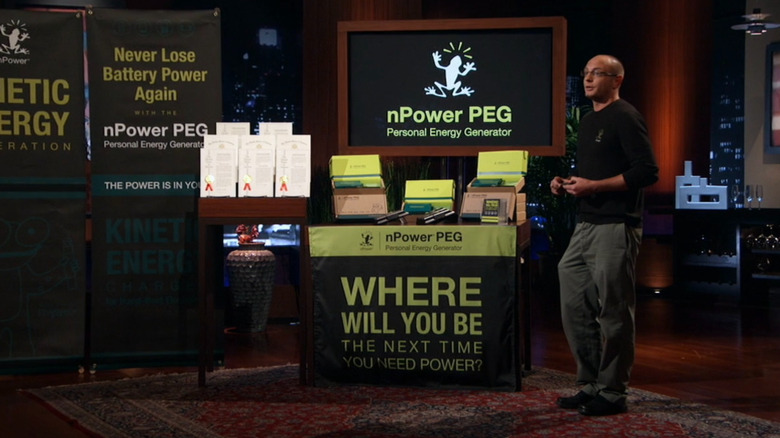What Happened To The nPower PEG From Shark Tank Season 4?
We may receive a commission on purchases made from links.
With phones, tablets, and other devices being an integral part of our day-to-day lives, investing in a portable power bank can be a life-saver while camping, traveling on the road, or going on a hike. But while alternative energy sources such as solar panel phone chargers have been picking up more attention, you may have never considered one powered by motion.
In "Shark Tank" Season 4, you would see Aaron LeMieux unveil his own innovative solution to this problem with his creation, the nPower PEG, a phone charger that is both portable and powered by human motion. So long as the charger is in your backpack, suitcase, or purse while you're moving about throughout the day, it will remain charged and be able to power up your devices with ease. While the sharks found the invention and LeMieux's sales decent enough, his grander vision to use the technology for the creation of a renewable energy source was seen as a far more admirable effort. Nevertheless, the investors didn't connect with LeMieux's overall strategy to get to that point, leaving the entrepreneur empty-handed by the end.
Aaron LeMieux launched Tremont Electric in 2007 with the support of his wife after working as an engineer in the corporate space for many years. With the reliance on mobile devices seeing a surge, LeMieux saw an opportunity to create an energy source that was both portable and environmentally friendly. His first prototype came out in 2010, and it would start selling online and in small retailers.
What happened to nPower PEG on Shark Tank?
Aaron LeMieux didn't think small when he entered the tank, with the entrepreneur proposing a $2 million investment for a 22% equity take in the nPower PEG. He presented his device and describes how it functions, explaining that the battery was continuously charging due to its internal kinetic energy generator. The product would be marketed towards individuals who have trouble accessing energy sources to charge their devices, such as hikers and boaters.
LeMieux shared that the team has sold 1,300 units through online sales for $199, generating approximately $130,000 in revenue, although the $110 production cost of each unit takes a good bite out of profits. He then explained the end goal was to utilize the same motion-sensing technology to harness the ocean's energy and create mass wave underwater power generators. Having heard this, Kevin O'Leary believed that the company was wasting their time creating phone chargers rather than licensing their tech to turbine companies. While LeMieux wasn't against this notion, he shared that his primary goal at this point was to generate revenue and prove the concept's viability.
As a whole, the Sharks failed to see the vision. Mark Cuban went out first, stating that LeMieux approached the pitch incorrectly by failing to share his sales and the bigger plan early on. Robert Herjavec, despite admiring the vision for sustainable energy, had a hard connecting the dots on how the nPower PEG would help them get there. Both Lori Greiner and Daymond John deemed themselves ill-fit partners for the company. Kevin O'Leary showed some intrigue, but found the $2 million valuation to be ridiculous.
nPower PEG after Shark Tank
Even though Aaron LeMieux failed to strike a deal with the sharks on the show, it didn't mean that all hope was lost. The Sharks, despite not investing, all expressed their confidence in LeMieux's idea, while the entrepreneur himself felt that his company was on the right path to becoming a billion-dollar business.
The nPower PEG's "Shark Tank" segment aired on April 26, 2013. The episode generated interest in his technology, leading to an array of unique proposals and an increased interest from LeMieux to work alongside other companies and solve problems. However, some stood out more than others. "For example, we received a request to look into the possibility of our technology to assist with lion tracking collars," he shared in an interview with The University of Toledo. "Can you picture a worse job than the person who has to change the batteries on lion tracking collars? Well with our technology, the movement of the lion itself will constantly charge the tracking collars so it will never have to be changed again." Along with this, he also shared his ambitions to develop similar tech solutions for military purposes, as well as his continued determination to produce a wave energy generator.
Without his $2 million investment, however, LeMieux knew he'd have to approach his ambitions practically. He continued, "I would rather make $20,000 mistakes rather than $20 million mistakes so we are perfecting the technology on a small scale first. But using this same technology and changing the size of the generators could be the most cost effective way of creating energy that can be fed right back into the grid."
Why did nPower PEG go out of business?
nPower PEG and its parent company, Tremont Electric, didn't last long after "Shark Tank." According to founder Aaron LeMieux's LinkedIn, doors closed in October 2015. No information is available regarding why the business folded. The closest to any sort of explanation is the LinkedIn description on Lemieux's Experience page, which simply states, "And then something terrible happened..." But there was no further information as to what this entailed. As of this writing, nPower Peg only exists on X, formerly known as Twitter, which has had no new posts since 2013.
While the nPower PEG was around, it sold at retailers such as REI and Amazon. Reactions to the product itself were mixed. On Amazon, it holds a 3.5 out of five-star rating average with two reviews. One reviewer was pleased with how it performs during their regular jog, while the other found it ineffective after a lengthy hike, while also being upset by its lack of a lightning adapter for later iPhones. A 2012 review from Wired reacted in a similar manner, rating the product five out of 10. The reviewer found it to be mostly effective at its task and liked its portability, but found that its method of charging up to be inconsistent, while its magnetic attraction did harm to credit cards and hard drives. Many were also disappointed that the nPower PEG didn't charge laptops like other portable chargers.
What's next for nPower PEG's founder?
As sad as it is that Aaron LeMieux never got to see his vision for a clean portable energy source come to full fruition, it's not hard to imagine what sank his business. As promising as the nPower PEG was, it was a concept that he spent more time and energy on than was necessary. His larger idea for implementing the technology into the creation of wave energy generators seemed to have a lot more promise and should have been what he focused his attention and resources on. Sadly, after this fact became more apparent, it seemed he may have been too deep into his initial endeavor to turn back given his comments regarding the company's need to develop its technology on a smaller scale.
LeMieux went on to work in a drastically different industry following the closure of Tremont Electric. Starting in 2015, he began working in the medical industry as an EMT, paramedic, and instructor. Between 2016 and 2020 he attended Cleveland State University where he received a Master of Science in Biomedical Engineering. Afterward, he received an Associate's degree in Nursing from Kent State University in May 2023. He currently works part-time as a Lead Fluid Mechanics Instructor at Cleveland State, while also working in the Cleveland Clinic as a Critical Care Transport Paramedic and a nurse.
"Shark Tank" is available for purchase on Prime Video.




